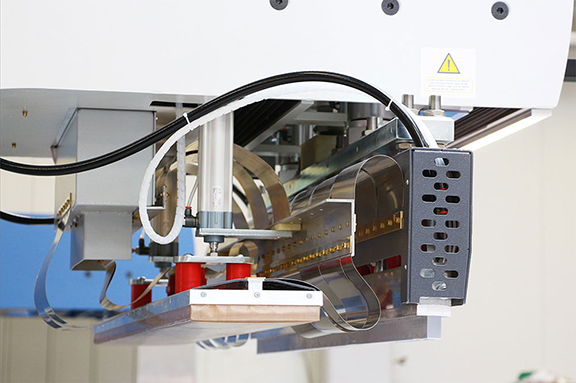高周波布地溶接では、接合する部分に高周波を印加することで、材料をヒートシールすることが多い。高周波溶接では、加熱プロセスは内側から外側に向かって行われます。直線的な製品や特殊な形状の製品を製造する業界では、ほとんどの作業で高周波溶着に頼っています。
RF溶接の仕組み
高周波(RF)溶接は、高周波電磁エネルギー(HF)を利用して材料の融合を完成させます。このプロセスでは、接合したい部品を高周波電磁界にかけます。無線周波数(RF)と高周波数(HF)は、大陸によって使い分けられる用語です。
溶接を開始する前に、電磁エネルギーが2本の金属溶接棒の間に交番電界を作ります。これらのバーは、加熱中や冷却中の加圧アプリケーターとしても機能する。作り出された電場は極性分子を振動させ、電磁場と共鳴する向きをとらせる。振動は1秒間に27.1MHz、つまり2710万回起こる。
通常4秒から12秒の時間をかけて、このプロセスは温度を上昇させ、材料を溶融させるエネルギーを発生させる。溶接バーをクランプして圧力を加えると、溶接部が形成される。このプロセスは、エネルギー、時間、圧力の適切な組み合わせで分子溶接を形成する。
RF溶接により、産業界は看板や 防水シートのような一貫した直線溶接を行うことができる。また、この溶着技術は、水タンク、オイルブーム、テントの峰などのユニークな形状を作るのに理想的です。ここでは、インパルス溶接よりも高周波布地溶接を選ぶべき理由を説明します。
インパルス溶接は通常、ウィンドウ・シェードやその他の軽工業材料の用途に使用されます。 熱はトップ・パネルとセカンド・パネルを通過する必要があるため、インパルス溶接では厚い材料は推奨されない。 さらに、インパルス技術の溶接時間は、RF溶接技術に比べてかなり長い。
溶接時間を大幅に短縮
高周波溶接はサイクル・タイムが速いため、 溶接に費やす時間が短縮される。また、このプロセスでは熱を局所化できるため、全体的な溶接速度が大幅に向上します。高周波は分子を励起し、分子の動きを活発にして熱を発生させます。内部の熱がポリウレタンを溶かし、材料が融合します。
連続的な熱供給により、一貫した溶接プロセスが維持されます。また、RF溶接の熱により材料が内側から密閉されるため、融合プロセスも迅速に行われます。
RF溶接では、溶接時間を最小限に抑えるだけでなく、積極的に作業を制御することができます。この機能は、可能な限り最短時間で溶接機を冷却および加熱するのに役立ちます。時間を大幅に節約しながら、溶接プロジェクトで使用するエネルギーを削減できます。
工具を使ったさまざまな形状の溶接
RFプロセスは、分極分子を持つ多様な熱可塑性材料に適している。RF溶接は、ポリウレタンやポリ塩化ビニル素材に適しています。RF溶着の汎用性の高さにより、RF溶着は多くのお客様から支持されています。多様な厚さ、化学成分、色の布地を溶接できます。さらに、この溶接技術でユニークな形状やシールを作成することができます。
誘電体シーリング時に加熱を局所化するための工具を使うこともできる。最終的に、元の材料よりも強力な結合を持つシームレスな部分ができる。溶接が完了したら、溶接製品を仕様どおりに仕上げることができます。RF溶接は、空気が充填された製品のシールに役立ちます。このプロセスでは、圧力を加える前に表面の厚さを不安定にし、新しい融合シームを作成することができます。
特注の金型を使って、製品の形状や機能を作りましょう。また、複雑な溶接を行う必要がある場合は、特殊な染料を使用することもできます。RF溶接は通常、優れた性能を発揮する。RF溶接はまた、特にポリウレタン素材を溶接する場合に、拡張された汎用性を提供します。
複数の生地を簡単に溶着
RF溶接では、溶接が必要な材料をシール用染料の間に挟んでから溶接を開始する。加熱は内部から行われるため、材料の層を簡単に溶接することができる。基本的に、分子を所定の位置に配置すれば、電極からの圧力により、問題なく永久的な継ぎ目を作ることができる。
また、高周波溶着を使ってポリウレタンとビニールなどの別の素材を溶着することもできます。この場合、適合性を確認することを忘れないでください。RF溶接を使用すると、不要な物質を排除した製品ができあがります。また、RF溶接を使えば、パッチやサポート・ストラップの溶接も容易になります。
すでに溶接された材料の上に溶接する
RFウェルディングは、他のウェルディング・プロセスとは異なり、すでにウェルディングされた部分に複数回当てることができる。その上、穴を開けたり、使用する布地に損傷を与えたりする危険性もありません。複雑なウェルドを作成する必要がある場合は、専用のダイを最大限に活用してください。
高周波溶接のこの利点により、多様な製造プロジェクトに適合する、より強力な継ぎ目を確実に作り出すことができます。高周波溶接を使用する際、接着剤や副産物は必要ありません。このプロセスでは、時間、RFエネルギー、圧力を組み合わせて、シール全体に堅牢で均一な溶接を行います。
この包括的なプロセスにより、溶接継ぎ目は周囲のどの材料よりも強度を保つことができる。全体として、気密性と防水性の高い溶接が完成します。
曲線と半径の溶接能力
製品に個性的で装飾的なタッチを加えたいですか?RF溶接はあなたの期待を裏切りません。溶接ツールに彫刻を施し、製品を装飾するために使用することができます。この溶接プロセスにより、素材と同じくらい長持ちする、水密な継ぎ目を持つより強力な溶接部が形成されます。
RF溶接は、曲線形状や、インパルス溶接では制限のある困難な領域の溶接を可能にします。RF溶接の最新情報は、当社のブログをご覧ください。高周波溶接は、その汎用性により医療機器製造に最適です。
このプロセスにより、メーカーは、創傷ケア機器、患者保温製品、液体ポーチのための堅牢な漏れ防止シールを作成することができます。RF溶接は、安全製品、保護具、水分補給ポーチなどのヒートシールされた軍事用アプリケーションを作成するのに理想的です。
高周波溶接の応用
さまざまな産業が高周波溶接の利点を最大限に活用しています。この技術の一般的な用途には、以下のようなものがあります:
-
医療用血漿バッグ
-
ビニールバナーと看板
-
工業用カーテンウォール
-
ビニール製バインダーカバー
-
輸送用ブリスターパック
-
輸送用椅子張りトリミング
-
テント
-
防水シートとカバー
通常、大量に生産する場合は、高周波溶接を使用するのが便利である。このプロセスで使用される機械は、新しいアイテムを生産するたびに独自のリセットが必要です。したがって、大量生産に使用すれば、より多くの成果が得られ、技術の潜在能力を最大限に活用できる。基本的に、1回限りの品目を溶接する場合、高周波溶接は実用的な選択肢ではないかもしれない。
最高の高周波溶接ソリューションを見つける
全体として、RF溶接はインパルス溶接に比べ て複数の利点がある。このプロセスはまた、多様な溶接ニーズに対して、より多用途で効率的な溶接プロセスを提供します。このコスト効率の高い溶接プロセスを選択すれば、いつでも時間と費用を節約できます。
お客様の用途に最適な溶接技術の選択にお困りですか?Miller Weldmaster の専門家にご相談ください。お客様のプロジェクトに最大限の結果をもたらす溶接技術をご案内いたします。お客様の材料を当社の機械でテストし、期待を裏切らない溶接技術についてご案内いたします。
精度と汎用性を保証する高性能溶接ソリューションを提供します。当社の高周波溶接技術で、時間とコストを節約してください。お客様の生産に適した技術と機械を決定するお手伝いをいたします。




.png)